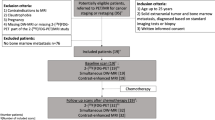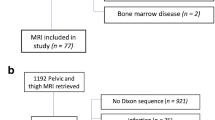Abstract
Objective
To determine the prevalence and appearance of magnetic resonance imaging (MRI) signal changes that occur in local bone marrow after radiation therapy (RT) and/or chemotherapy for extremity soft tissue sarcoma (STS).
Materials and methods
Seventy patients with primary STS at the level of a long bone who also had undergone pretreatment MRI and at least one post-treatment MRI of the tumor bed were identified. MRIs of each patient were retrospectively reviewed for new changes in marrow signal in the region of the tumor bed and for the morphology, relative signal intensities, heterogeneity, and progression or regression of changes over time.
Results
Focal signal changes in marrow were observed in 26/70 patients (37%) at a median of 9.5 months after RT and/or chemotherapy and diffuse changes in seven (10%) at a median of 8 months. Patients who received neither RT nor chemotherapy did not develop marrow changes. Mean RT doses in patients with changes and those without were 5,867 and 6,076 cGy, respectively. In most patients with focal changes, changes were seen in all sequences and were linear–curvilinear, patchy, or mixed at the level of the tumor bed. Predominant signal intensity of changes was between muscle and fat at T1WI and between muscle and fluid at fat-saturated T2WI or short tau inversion recovery. Most focal changes enhanced heterogeneously and increased or fluctuated in size over time.
Conclusion
Changes in MRI appearance of long bone marrow frequently are evident after combined RT and chemotherapy for STS and most commonly increase or fluctuate in size over time. These changes have various non-mass-like configurations and often show signal intensities similar to those of red marrow and thus should not be mistaken for metastases. The marrow changes might represent an early stage of gelatinous transformation of marrow.








Similar content being viewed by others
References
Ramsey RG, Zacharias CE. MR imaging of the spine after radiation therapy: easily recognizable effects. Am J Roentgenol 1985;144: 1131–1135.
Stevens SK, Moore SG, Kaplan ID. Early and late bone-marrow changes after irradiation: MR evaluation. Am J Roentgenol 1990;154: 745–750.
Yankelevitz DF, Henschke CI, Knapp PH, Nisce L, Yi Y, Cahill P. Effect of radiation therapy on thoracic and lumbar bone marrow: evaluation with MR imaging. Am J Roentgenol 1991;157: 87–92.
Blomlie V, Rofstad EK, Skjonsberg A, Tvera K, Lien HH. Female pelvic bone marrow: serial MR imaging before, during, and after radiation therapy. Radiology 1995;194: 537–543.
Mitchell MJ, Logan PM. Radiation-induced changes in bone. RadioGraphics 1998;18: 1125–1136.
Otake S, Mayr NA, Ueda T, Magnotta VA, Yuh WTC. Radiation-induced changes in MR signal intensity and contrast enhancement of lumbosacral vertebrae: do changes occur only inside the radiation therapy field? Radiology 2002;222: 179–183.
Mullen LA, Berdon WE, Ruzal-Shapiro C, et al. Soft-tissue sarcomas: MR imaging findings after treatment in three pediatric patients. Radiology 1995;195: 413–417.
Kransdorf MJ, Peterson JJ, Bancroft LW, Buskirk SJ, O’Connor MI. Extremity marrow changes following radiation therapy for soft tissue sarcoma [abstract]. Skeletal Radiol 2006;35: 333–334.
Kransdorf MJ, Murphey MD. Imaging of soft tissue tumors. 2nd ed. Philadelphia: Lippincott Williams & Wilkins; 2006: 63–64.
Sacks EL, Goris ML, Glatstein E, Gilbert E, Kaplan HS. Bone marrow regeneration following large field radiation: influence of volume, age, dose, and time. Cancer 1978;42: 1057–1065.
Böhm J. Gelatinous transformation of the bone marrow: the spectrum of underlying diseases. Am J Surg Pathol 2000;24: 56–65.
Vande Berg BC, Malghem J, Devuyst O, Maldague BE, Lambert MJ. Anorexia nervosa: correlation between MR appearance of bone marrow and severity of disease. Radiology 1994;193: 859–864.
Vande Berg BC, Malghem J, Lecouvet FE, Lambert M, Maldague BE. Distribution of serouslike bone marrow changes in the lower limbs of patients with anorexia nervosa: predominant involvement of the distal extremities. Am J Roentgenol 1996;166: 621–625.
Acknowledgment
We thank Murray Brennan, MD, for his insightful observations and discussions, and Mark Edgar, MD, for providing the pathologic correlation in Fig. 8.
Author information
Authors and Affiliations
Corresponding author
Rights and permissions
About this article
Cite this article
Hwang, S., Lefkowitz, R., Landa, J. et al. Local changes in bone marrow at MRI after treatment of extremity soft tissue sarcoma. Skeletal Radiol 38, 11–19 (2009). https://doi.org/10.1007/s00256-008-0560-2
Received:
Revised:
Accepted:
Published:
Issue Date:
DOI: https://doi.org/10.1007/s00256-008-0560-2




